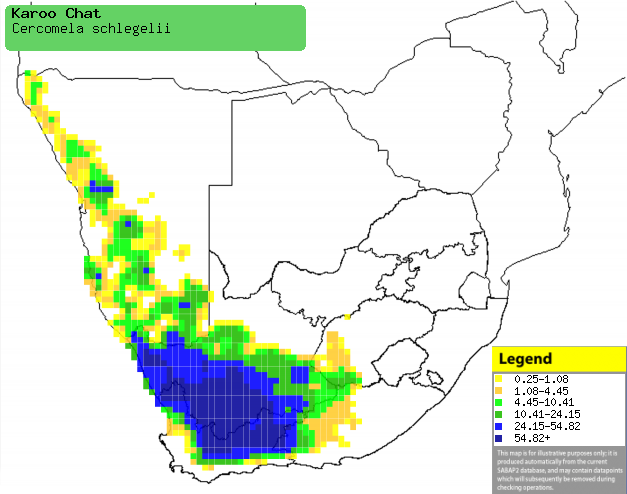|
Cercomela schlegelii (Karoo chat)
Karoospekvreter [Afrikaans]; Karoo-spekvreter [Dutch]; Traquet du Karroo
[French]; Bleichschmätzer, Wüstenschmätzer [German]; Chasco do Karoo
[Portuguese]
Life
> Eukaryotes >
Opisthokonta
> Metazoa (animals) >
Bilateria >
Deuterostomia > Chordata >
Craniata > Vertebrata (vertebrates) > Gnathostomata (jawed
vertebrates) > Teleostomi (teleost fish) > Osteichthyes (bony fish) > Class:
Sarcopterygii (lobe-finned
fish) > Stegocephalia (terrestrial
vertebrates) > Tetrapoda
(four-legged vertebrates) > Reptiliomorpha > Amniota >
Reptilia (reptiles) >
Romeriida > Diapsida > Archosauromorpha > Archosauria >
Dinosauria
(dinosaurs) > Saurischia > Theropoda (bipedal predatory dinosaurs) >
Coelurosauria > Maniraptora > Aves
(birds) >
Order: Passeriformes > Family: Muscicapidae
> Genus: Cercomela
Distribution and habitat
Near-endemic to southern Africa, occurring from
south-western Angola through Namibia to the Western and Northern Cape,
marginally extending into the Free State and the Eastern Cape. It generally
prefers succulent shrubland or stony hillsides within the Karoo; in the Namib
Desert it prefers perennial grassland on stony and gravelly plains. It rarely
wanders into villages, settlements and gardens, even if they are adjacent to a
favoured habitat.
|
 |
|
Distribution of Karoo chat in southern Africa,
based on statistical smoothing of the records from first SA Bird Atlas
Project (©
Animal Demography unit, University of
Cape Town; smoothing by Birgit Erni and Francesca Little). Colours range
from dark blue (most common) through to yellow (least common).
See here for the latest distribution
from the SABAP2. |
Food
It mainly eats insects, doing most of its foraging on the
ground, probing the bases of grass tufts and shrubs in search of food. It may
also catch termites and other prey in soil mounds, especially if they have been
freshly dug by an Aardvark (Orycteropus afer) or Bat-eared fox (Otocyon
megalotis). The following food items have been recorded
in its diet:
- Insects
- Fruit of Lycium (honey-thorns)
Breeding
- The nest is built solely by the female in about 8 days, consisting of a
deep cup set into a foundation of small twigs and sticks, lined with fluffy
seeds or another soft material. It is typically placed on the ground beneath
a shrub, usually facing south or south-east to maximise shade during the
heat of the day.
- It can breed opportunistically in response to rain at any time of the
year but egg-laying season is mainly from August-March.
- It lays 2-4 pale greenish blue eggs, freckled with reddish brown.
- The chicks are fed by both parents, who often mimic an injury-stricken
bird in an attempt to coax a predator away from the nest.
Threats
Not threatened.
References
-
Hockey PAR, Dean WRJ and Ryan PG 2005. Roberts
- Birds of southern Africa, VIIth ed. The Trustees of the John Voelcker
Bird Book Fund, Cape Town.
|
